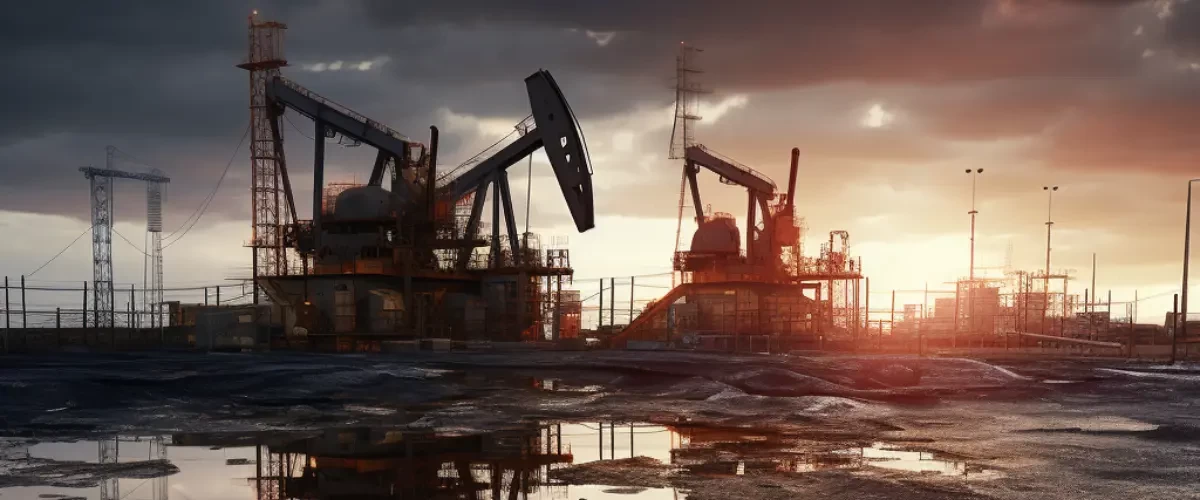Fueling the Future: The Transformative Role of Technology in the Oil and Gas Industry
Given the current hype around digital technologies, it's easy to see them as a ready-made solution for handling increasing business difficulties. For example, the industrial Internet of Things, a subset of the broader digital opportunity, is expected to add $15 trillion to the global economy by 2030. But, when the industry in question is undergoing a fundamental transformation as a result of shales, how can US midstream firms not only embrace a digital attitude but also derive genuine value from becoming digital for their heritage and new assets?
Oil tycoons can no longer wait for the 'Boom' to occur. The industry must unlearn what it knows in order to be profitable at $50 per barrel. It is critical to understand that the industry's ability to invest in innovation is affected by the price of oil. Companies were merely focused on staying afloat with healthy cash flow during the downturn that began in 2014, when prices dropped to the $30 area. However, with the current price of $60, the same companies are now at a tipping point where they can afford to make small expenditures in innovation to help them compete. In fact, even if costs were to rise to $80 or $90, there would still be a market.
Oil and gas giants, in particular, are adopting AI to improve site finds, with analysts predicting that the oil and gas AI market will more than double in size between 2020 (when it was valued $2.1 billion) and 2024. Saudi Aramco recently invested in Earth Science Analytics, which provides predictive software tools to analyze and identify properties of potential exploration sites, and TotalEnergies announced plans to open a digital factory using AI to facilitate field discovery in 2019.
Several cutting-edge technologies are showing considerable promise in the oil and gas sector:
- Artificial Intelligence (AI): AI is employed to automate tasks, enhance decision-making processes, and identify potential issues. For instance, AI can analyze sensor data to detect pipeline leaks or predict the maintenance requirements of equipment.
- Internet of Things (IoT): The IoT involves linking physical devices to the internet, enabling them to collect and share data. This data contributes to improved efficiency, safety, and environmental performance. For instance, IoT sensors can monitor pipeline temperature and pressure, aiding in leak prevention.
- Big Data Analytics: This involves analyzing vast amounts of data to discern patterns and trends, facilitating better decision-making, operational optimization, and the identification of new opportunities. For example, big data analytics can analyze customer data to identify potential markets or optimize oil and gas production.
- Robotics and Automation: Robotics and automation are deployed for hazardous or repetitive tasks, enhancing safety and efficiency. For instance, robots can be utilized for pipeline cleaning or operating drilling rigs.
- 3D Printing: 3D printing is employed to produce prototypes, parts, and tools, leading to cost reduction and improved efficiency. For example, custom parts for oil and gas equipment can be created through 3D printing.
These represent just a selection of the contemporary technologies reshaping the petroleum and gas industry. As these technologies continue to evolve, their impact on the industry is expected to become even more pronounced.
Recent Technological Advances
In 2011, the National Petroleum Council disclosed that the technically recoverable resource base for oil and gas comprised 2.3 quadrillion cubic feet of natural gas and 167 billion barrels of oil. Advanced technology plays a crucial role in rendering this resource economically viable while adhering to environmentally responsible practices.
Over the past five to ten years, notable progress in technology development, both offshore and onshore, has concentrated on several key areas:
- Sophisticated Data Utilization: This involves advanced data acquisition, processing, and visualization applied throughout the sector, spanning from exploration to field maintenance and the secure closure of wells.
- Water Conservation and Protection: Emphasizing treatments that enable water reuse and the utilization of brines and non-potable water in oil and gas applications, contributing significantly to water conservation efforts.
- Materials Science: Particularly advancements in cements and metals used for ensuring wellbore isolation and integrity.
- Reservoir Recovery Factor Enhancement: Technologies designed to increase reservoir recovery factors, with a particular focus on stimulation methods.
- CO2 Enhanced Oil Recovery (CO2 EOR): This innovative technique combines increased oil and gas recovery with carbon sequestration, presenting a promising avenue for gaining experience in carbon sequestration.
- Oil Spill Prevention Technology: Specifically designed for operations in deep- and ultra-deepwater environments.
- Research and Development for Extreme Environments: Especially targeting operations in environmentally sensitive areas such as the Arctic, which holds substantial oil and gas resources.
Overall, the most impactful technological advancements have occurred in the realm of drilling and completions, encompassing horizontal drilling, extension, and hydraulic fracturing.
Automation in the Oil and Gas Field
The technology employed in today's oil and gas industry is exceptionally advanced. At Devon's WellCon center, engineers have the capability to remotely monitor a project on screen, overseeing the drilling of a 2-mile-long well located 10,000 feet underground. If the drill deviates from the designated "sweet spot," which can be as precise as 10 feet across, an alert is triggered, prompting engineers to instruct the crew for necessary adjustments. This level of precision is achievable only through automation, highlighting one among numerous advantages that the industry can derive from automated processes.
Additional notable benefits include:
- Monitoring Capabilities: Automation enables oil and gas companies to oversee their pipes and networks with unprecedented vigilance. Systems like RealSens and investments in terminal automation allow for the remote monitoring of entire pipeline networks, detecting leaks. Autonomous underwater vehicles and unmanned aerial vehicles are utilized to observe onshore and offshore pipelines for safety, deterring criminal activity, preventing terrorist attacks, and facilitating repairs. Weather monitoring systems can also detect changes in seismic activity, oceanic conditions, and atmospheric levels.
- Reduced Operating Costs: According to McKinsey & Company, effective utilization of digital technologies has the potential to decrease capital expenditures by up to 20%.
- Predictive Maintenance: Advanced analytics can preemptively identify issues before equipment breakdowns occur, leading to a potential decrease in maintenance costs by as much as 13%.
- Reservoir Enhancement: Digital automation technologies have enabled companies to expand reservoir capacities.
- Safety: Automation eliminates the need for workers to undertake risky repairs in the field. Instead, augmented reality or drones can be employed for necessary repairs.
- Efficiency in Marketing and Distribution: Advanced analytics offer oil and gas companies insights into consumer habits and preferences, facilitating optimized pricing models and more efficient supply chain management. Geospatial analytics, for example, assist in route optimization and location planning for different networks.
Advancing Upstream with Digital Innovations in the Oil and Gas Sector
- The oil and gas industry is poised for a significant digital transformation, echoing the impact observed in various sectors.
- Integration of advanced technologies, such as sensors, automation, and big data analytics, in exploration and production can enhance efficiency and cost-effectiveness in drilling and production operations.
- Companies utilizing automated tools have the opportunity to streamline their supply chains.
- Advanced analytics and data visualization tools can optimize refinery and petrochemical plant performance, as well as enhance monitoring and control of the entire value chain.
- Realizing these benefits requires substantial effort, especially for companies deeply entrenched in legacy systems.
- Active adoption and appropriate integration of new technologies are crucial for companies navigating the industry's complexity, vast scale of operations, and production costs.
- Despite potential challenges, committing resources and fostering collaboration, teamwork, and leadership are essential for improving industry functions, enhancing efficiency, and leveraging new technologies in the upstream sector.
Addressing issues:
- Numerous existing and emerging technologies play crucial roles in the upstream segment, spanning exploration, geological surveys, obtaining land rights, onshore and offshore drilling, and production.
- Technologies include automation, drones, robotics, cloud and big data management tools, augmented reality (AR), virtual reality (VR), sensors connected to the Internet of Things (IoT), and 5G.
- New technologies have the potential to boost recovery by 3% to 4%, with actual impacts depending on transformation success, oil prices, and other variables.
OVERCOMING MISCONCEPTIONS AND FEARS
Despite the evidence supporting the benefits of modern technology, some professionals in the oil and gas business are unsure of the broad role that technology should play in this environment. Fear of job disruption as a result of potential cybersecurity intrusions is one of their concerns, as is the amount of time required to complete the migration to new technology. The concerns of pipeline breakdowns causing oil or gas to leak, as well as theft or terrorist attacks, are valid and necessitate the adoption of tight rules for installation and security. However, in the future, digital pipeline solutions will provide consumers with more secure, reliable, and continuous services, not just for monitoring and maintenance.
These solutions consist of five essential components:
- Backbone Transmission: This involves a fiber cable running along the pipeline's length, serving as the core transmission infrastructure.
- Integrated Remote Site Power Supply Solution: A comprehensive solution catering to the power supply needs of remote sites associated with the pipeline.
- Communication and IoT Edge-Device Intelligence: Incorporates intelligent devices at the edge of the network, facilitating communication and Internet of Things (IoT) capabilities.
- Machine Vision Security Monitoring System: Utilizes smart cameras trained to identify and report various issues in real time, enhancing security through visual monitoring.
- Machine Learning (ML) Software: Trained for detecting intrusions and leakages, this software promptly reports concerns, adding a layer of intelligence to the overall system.
Collectively, these elements fulfill the communication and production requirements of pipelines, introducing operational intelligence that contributes to cost reduction and overall efficiency improvement.
Conclusion:
To summarize, the oil and gas industry has a long history of driving revolutionary change in the digital era, but its rate of digital transformation in the twenty-first century has been noticeably slow. However, the industry cannot afford to disregard the need for modern technical advancements and effective data usage. In a constantly changing energy market, the industry may unleash new prospects for enhanced productivity, efficiency, and sustainability by embracing digital transformation.
Keep in mind that the future belongs to those who can adapt and innovate. By fully embracing digital transformation, the oil and gas industry has the ability to rethink its operations, enhance efficiency, and contribute to a sustainable energy future. The industry may speed its digital transformation by collaborating with Global Lancers and using their experience.
Recent Posts





Tags
-
Business



Add Comment
0 Comments